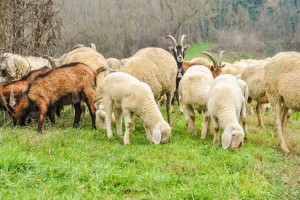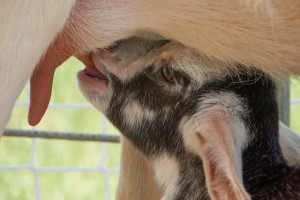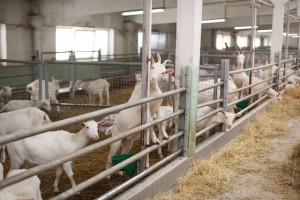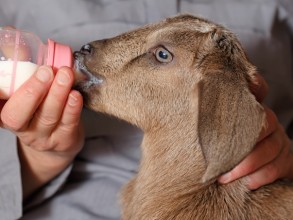Goat Diseases

Caprine Arthritis Encephalitis Virus (CAEV) is a small ruminant lentivirus similar to Maedi-visna Virus (MVV). Both lentiviruses can transmit between both species, therefore mixed grazing should be avoided on farms affected by either CAEV or MVV.
Caprine Arthritis Encephalitis Virus (CAEV)
Also known as Small Ruminant Lentivirus (SRLV) or Lentivirus
Caprine (relating to goats) Arthritis Encephalitis Virus (CAEV) is a small ruminant lentivirus (similar to Maedi-Visna irus (MVV), a virus found in sheep) which is responsible for major production losses in goats worldwide. In CAEV infection (Peterhans et al., 2004) the areas most commonly affected are the joints, although it can also affect the mammary glands which causes significant problems in the dairy goat industry. MVV also affects the ewes mammary glands but other classical target organs include the lungs and brain. It is important to note that natural sheep-to-goat, and goat-to-sheep transmission of CAEV and MVV can occur in mixed flocks (Reina et al., 2009).
There are some countries where SLRVs have never been reported, and some that have managed to eradicate the virus from livestock including Iceland, Australia and New Zealand.
Clinical disease
Early diagnosis of CAEV is essential for control, prevention and welfare reasons, unfortunately however, the clinical symptoms for CAEV are often non-specific (Reina et al., 2009). Antibody or viral detection are required for confirmation, nonetheless, the multi-system disease symptoms caused by CAEV are:
- Arthritis (used to be known as ‘Big Knees Disease’) – more common in older goats
- Pneumonia – labored breathing in both mature goats and kids
- Mastitis in does
- Weight loss and rear limb weakness
- Encephalitis (more common in kids) (APHIS, 2008)

The lactation route, e.g. a kid ingesting infected milk from a doe is the most important mode of transmission of CAEV.
Genetic factors of both the host (breed and family-related disease susceptibility) and the virus (virulence) influence the outcome of CAEV infection (Peterhans et al., 2004).
Routes of transmission – how is CAEV spread?
The most important transmission route is the ingestion of colostrum and milk by young kids from infected does (known as lactation route). Colostrum mixed together from different does has been identified as a critical source of spread in herds. The virus can be in colostrum or milk just as free virus particles or inside cells (Blacklaws et al., 2004).
However, CAEV is not just spread via the lactation route, when uninfected does were milked with infected does in the US, a high percentage became infected in less than 10 months (Adams et al., 1983). In fact housing and direct contact have long been recognized as major risk factors for CAEV (and MVV, Blacklaws et al., 2004).

Dairy goats grouped in stalls. Housing susceptible animals with infected animals is also an major risk factor in the spread of CAEV.
Direct face-to-face contact, aerosol droplet infection and indirect transmission by contact with virus-contaminated food, water troughs and bedding have been suggested (Blacklaws et al., 2004). Management such as long housing periods, high stocking density and poor ventilation may facilitate virus exposure.
Economic consequences of CAEV
In goats increased Somatic Cell Counts (SCC) have been reported in CAEV seropositive goats free of bacterial udder infection (Sanchez et al., 2001). These findings emphasize the need to establish control and prevention strategies against CAEV (Reina et al., 2009).
CAEV affects the reproductive performance and health of dairy goats. It has been shown to affect the productivity of older does (more so than younger ones), supporting the suggestion that CEAV is an immunodeficiency disease. Additionally incidence of disease is higher amongst infected does.
In kids decreased birth weights and poorer growth rates prior to and during weaning (Greenwood, 1995) and increased kid mortality have been demonstrated in offspring of CEAV seropositive does.
Control and Prevention of CAEV
Kids – birth to weaning

Colostrum or milk heated for one hour at over 56 degree Celsius is free from virus, and therefore considered safe to feed to kids.
Decreasing CAEV prevalence diminishes the incidence of clinical infection and avoids direct production losses in does and kids. It also improves animal welfare, minimizes culling and eliminates unnecessary vet costs.
Virus was not transmitted to kids fed virus-infected colostrum that had been heated at 56 C for 1 hour. Adams et al., in 1983 proposed a program of eradication in which kids are removed from their dams at birth, fed safe sources of colostrum and milk, and isolated from other goats until weaning.
Kids born to seropositive nannies will already be infected, however kids born to seronegative mothers will not be infected. Therefore, replacement animals in particular born from seronegative mothers should avoid milk and colostrum from seropositive dams, e.g., mixing colostrum from both infected and non-infected mothers, which is then fed directly to a batch of kids is likely to infect all of those kids.
Culling seropositive animals
Culling of seropositive animals has been applied with some success, however complete slaughter may cancel out any gains made by genetic selection programs (Reina et al., 2009).
CAEV and Welfare
CAEV has a significant impact on the animals welfare because of the poor quality of life of clinically infected animals which will suffer from pain (Peterhans et al., 2004).
Treating Caprine Arthritis Encephalitis Virus
There is no treatment for CAEV, and affected animals should be humanely destroyed.
Good Practice Based on Current Knowledge
- Maintain a closed flock policy
- Join Goat Health Schemes, talk to an animal health expert about an eradication program
- Pasteurize colostrum and milk for young kids on infected farms
- Where possible, stocking rates should be lowered and housing avoided
- Humanely destroy affected animals


 American English
American English

Comments are closed.